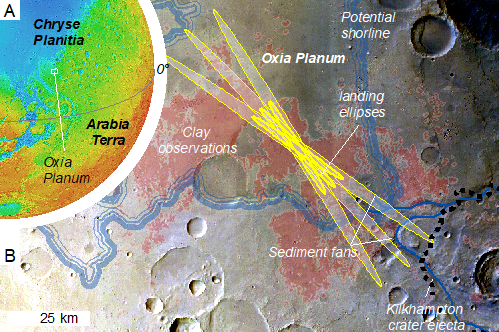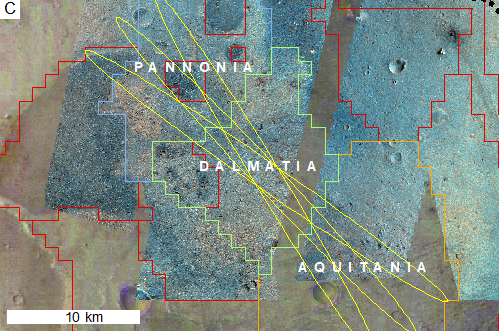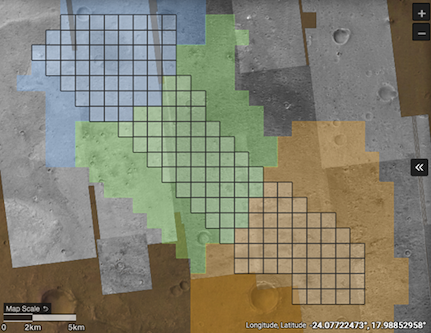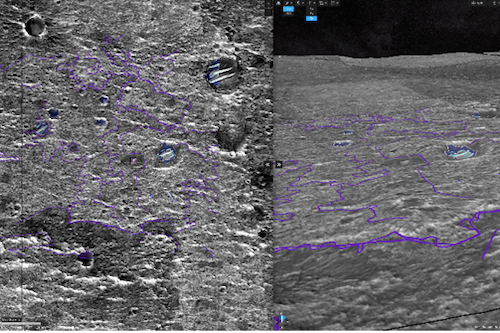- 1European Space Research and Technology Centre, European Space Agency, Noordwijk, Netherlands (e.sefton-nash@cosmos.esa.int)
- 2The Open University, Walton Hall, Milton Keynes, United Kingdom
- 3Laboratoire de Géologie de Lyon, Université de Lyon, France
- 4Institut für Planetenforschung, Deutsches Zentrum für Luft und Raumfahrt (DLR), Berlin, Germany
- 5University of Münster, Germany
- 6Istituto di Astrofisica e Planetologia Spaziali (INAF-IAPS), Via del Fosso del Cavaliere, Roma, Italy
- 7Laboratoire de Planétologie et Géodynamique, Université de Nantes, France
- 8Natural History Museum, London, UK
- 9Jet Propulsion Laboratory/California Institute of Technology, Pasadena, CA, USA
- 10Université Paris-Sud, Orsay, France
- *A full list of authors appears at the end of the abstract
Introduction: Oxia Planum (OP) is the selected landing site for the ESA-Roscosmos ExoMars Programme’s 2022 mission (Figure 1). The descent module and landing platform, Kazachock, will transport the Rosalind Franklin Rover to OP. With the primary goal of searching for signs of past and present life on Mars, Rosalind Franklin will investigate the geochemical environment in the shallow subsurface [1].


Figure 1: A) Locations of OP on (A) Mars and (B) in Arabia Terra. Phyllosilicate detections are in red [2]. Estimated/study landing ellipses are in yellow. -3000 m contour is shown in blue. Fluvial channels and sediment fan remnants are evident. C) Designation of mapping ‘Areas’.
Oxia Planum: OP lies at the transition between the ancient terrain of Arabia Terra and Chryse Planitia (Figure 1). OP forms a shallow basin, open to the north, characterized by clay-bearing bedrock, and contains units from ~mid-Noachian to ~early-Amazonian in age [3, 4]. There have been at least two distinct phases of aqueous activity within the landing site area. A first phase during the mid-Noachian (estimated age is 4.0 Ga) resulted in ~100 m of layered clay-rich deposits. These comprise Mg/Fe smectites overlain by more Al-rich materials. After a substantial hiatus the second phase of aqueous activity included a fluviodeltaic system. This fluvial activity post-dates the clay-rich layered unit, and is associated with the younger set of channels in Coogoon Vallis, which feeds into the Oxia basin. There is abundant evidence for intense erosion across OP. There are isolated buttes, perhaps remnants of a once-extensive layer that superposed the clay-bearing unit, and a dark, mafic-rich, resistant unit of Amazonian age (<3 Ga) that crops out in association with inverted landforms. Despite this erosion, crater statistics indicate that the clay-bearing rocks are Noachian in age, but have constantly been denuded. This supports the hypothesis that potential shallow subsurface organic biomarkers may have experienced low damage from exposure to cosmic radiation.
High resolution mapping campaign: Gaining a thorough understanding of the OP landing site prior to operations will provide testable hypotheses that facilitate interpretation of results, and hence provide an effective approach to address the mission’s science objectives. In pursuit of this, the ‘Macro’ sub-group, part of the Rover Science Operations Working Group (RSOWG), has been tasked to perform a detailed group mapping exercise of the OP landing site. The work prioritizes the area of highest estimated landing probability, but incorporates interpretations from elsewhere in the wider landing ellipse envelope and beyond. Complementary CTX scale mapping covers the wider area around the landing site and is described elsewhere [5]. The objectives of the campaign include to: (1) Provide a detailed geospatial dataset comprising mapped photo-geologic units, potential science targets, and surface features at OP. Via a follow-on reconciliation phase, and incorporating additional information from orbital or analogue data, a morpho-stratigraphic map of the landing site will be produced. (2) Familiarize scientists from across the different instrument teams and disciplines represented on RF with the geology and geography of the landing site in anticipation of rover operations. (3) Using the detailed scientific understanding enabled by the map, and elaborating on work completed during the landing site selection process, develop testable hypotheses that will (i) link mission-level science objectives to specific activities in the rover mission science operations strategy, and (ii) provide a basis for fine detail ‘rapid reconnaissance’ mapping (e.g. [6]) done after landing, when the precise location of the rover is established.
Schedule and Organisation: The campaign coordination/leadership team begun planning in Q4 2019 and team mapping exercise began in Q3 2020 with reconciliation underway in Q4 2020 (Figure 2). We use a grid of 1×1 km ‘quads’ to cover the estimated 3-sigma landing ellipse envelope (Figure 3). Of these, ~150 quads cover the 1-sigma estimated landing ellipse envelope, which we divide into 3 ‘Areas’ informally referred to as Pannonia, Dalmatia and Aquitania. 88 individuals associated with RSOWG who volunteered to map, are assigned quads amongst these Areas. Mapping is intended to be completed by August 2020.
Figure 2: Mapping campaign timeline and phases.
Data and Tools: The Multi-Mission Geographic Information System (MMGIS) [7] provides capabilities for group mapping and centralised data management for this project. An enhancement to MMGIS with additional functionality for geospatial analysis and mapping was developed for the NASA Mars 2020 Rover mission. We have deployed an instance of this tool at ESA ESTEC to facilitate group mapping. Volunteers map on a HiRISE orthorectified image and DTM mosaic. These data are co-registered with a CTX DTM and orthomosaic, which in turn are georeferenced to the HRSC MC11W mosaic [8]. In the mapping phase, many users concurrently map geologic contacts and surface features in their assigned quads. During the reconciliation phase, a smaller team is responsible for reconciling the maps produced by volunteers over all quads. The map data output are planned to be published and made accessible to the community.
Results: At the time of abstract submission the mapping phase is ongoing. Having successfully completed the initial training mappers are undertaking an ‘exploration phase’ in which they discover the contents of their quads to refine an overall geological unit definition to be used during the mapping phase. We present the preliminary mapping results and a status of the project, and provide an outlook towards publication of the map as a community resource, and for use in continued development of the ExoMars 2022 Mission science operations strategy.


Figure 3: Left – Distribution of quads and areas in MMGIS. Right – example terrain and mapping in MMGIS: HiRISE ESP_039299_1985.
References
Adam Parkes Bowen, Alex Barrett, Alice Le Gall, Andrew Coates, Andrew Griffiths, Christoph Statz, Elise Harrington, Frances Westall, George Cann, Joe McNeil, M. Cristina De Sanctis, Marco Ferrari, Nicolas Mangold, Nicole Schmitz, Rebecca Williams, Sandra Siljestrom, Stephen Lewis, Valérie Ciarletti, Agata Krzesinska, Andoni G. Moral, Andrea Pacifici, Angelina Kapatza, Anshuman Bhardwaj, Antonio Sansano, Barry Whiteside, Christian Schröder, Daniela Tirsch, Detlef Koschny, Dirk Plettemeier, Fernando Rull, Frédéric Foucher, Gorka Arana, Jack Wright, Jacqueline Campbell, Jan-Peter Muller, Javier Martin-Torres, Juan Manuel Madariaga, Julene Aramendia, Alfiah Rizky Diana Putri, Lydia Sam, Maria-Paz Zorzano, Martin Voelker, Rebecca Thomas, Robert Barnes, Sara Motaghian, Sarah Boazman, Sergey Nikiforov, Stephanie Werner, Steven Banham, Tomaso Bontognali, Walter Goetz, Wolf-Stefan Benedix, Benjamin Bultel, Tim Parker, Ben Man, Albert Haldemann, Andrea Apuzzo, Antonio Molina, Divya M. Persaud, Elena Favaro, Francesca Altieri, John Bridges, Klaus Gwinner, Nicolas Oudart, Pantelis Poulakis, Rickbir Bahia, Sanjeev Gupta, Stuart Turner, Tanya Lim, Yu Tao, Zsuzsanna Toth, Lucia Mandon
How to cite: Sefton-Nash, E., Balme, M., Quantin-Nataf, C., Fawdon, P., Volat, M., Hauber, E., Orgel, C., Frigeri, A., Le Deit, L., Ruesch, O., Adeli, S., Loizeau, D., Davis, J., Grindrod, P., Nass, A., de Witte, S., Calef, F. J., Soliman, T. K., and Vago, J. L. and the ExoMars Rover Science Operations Working Group (RSOWG) Macro Mapping Team: HiRISE-scale characterization of the Oxia Planum landing site for the Exomars 2022 Mission, Europlanet Science Congress 2020, online, 21 Sep–9 Oct 2020, EPSC2020-978, https://doi.org/10.5194/epsc2020-978, 2020.

